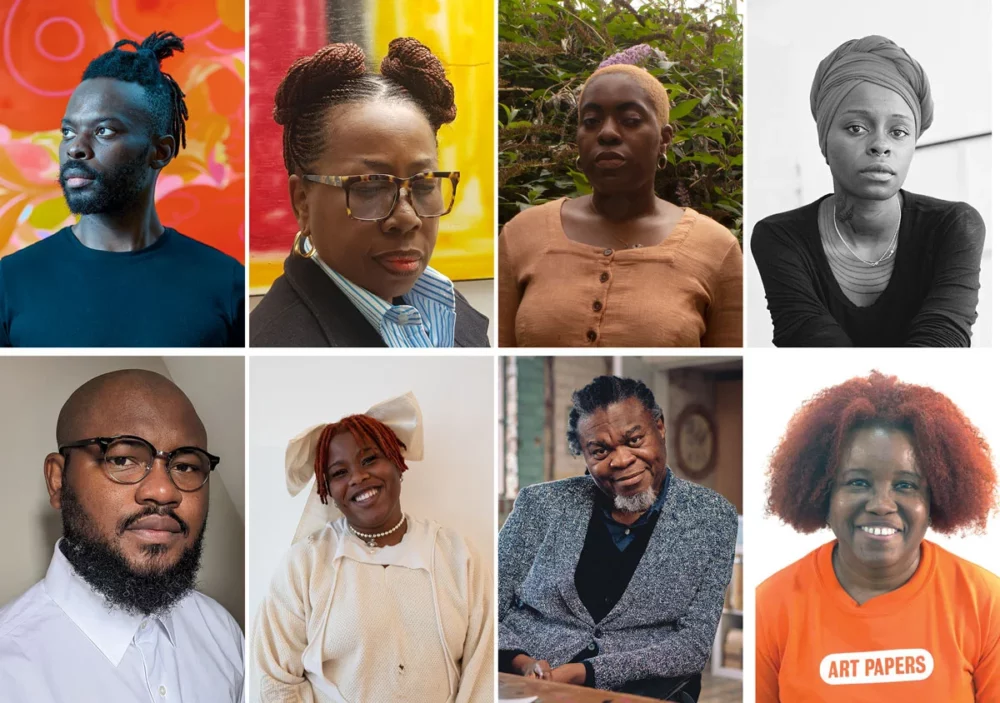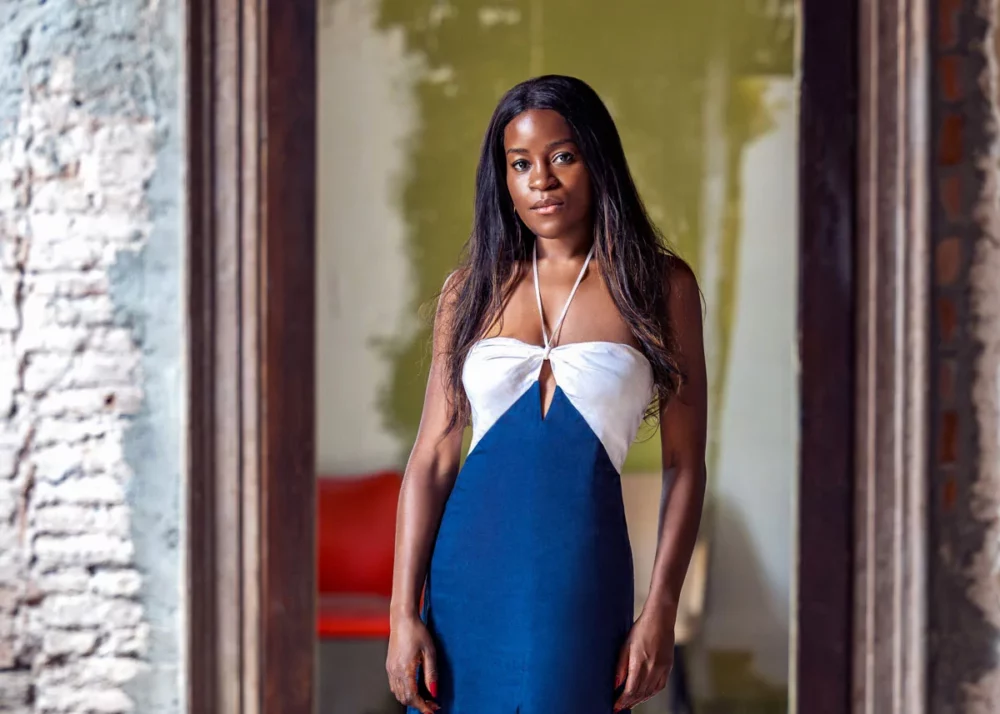
- Source: ART NEWS
- Author: MAXIMILÍANO DURÓN
- Date: JULY 21, 2023
- Format: DIGITAL
Second-Ever Nigerian Pavilion at Venice Biennale Will Feature Yinka Shonibare, Precious Okoyomon, Toyin Ojih Odutola, and More

The eight participating artists in the 2024 Nigerian Pavilion. From left, top row: Tunji Adeniyi-Jones, Ndidi Dike, Onyeka Igwe, and Toyin Ojih Odutola; bottom row: Abraham Oghobase, Precious Okoyomon, Yinka Shonibare, and Fatimah Tuggar.
PHOTO CREDITS: ADENIYI-JONES: ON WHIT WALL; IGWE : REGINE ULLRICH; OJIH ODUTOLA: BETH WILKINSON; SHONIBARE: TOM JAMIESON, 2023; ALL OTHERS: COURTESY THE ARTIST
Nigeria has announced the details for its national pavilion at the 2024 Venice Biennale, marking the second time the country has ever participated in the global art event.
Titled “Nigeria Imaginary,” the exhibition will feature an intergenerational group of nine Nigerian and Nigerian diasporic artists. Iit will be sited in a historical palazzo in Dorsoduro, near the Gallerie dell’Accademia.
Those artists are Tunji Adeniyi-Jones, Ndidi Dike, Onyeka Igwe, Toyin Ojih Odutola, Abraham Oghobase, Yinka Shonibare, Fatimah Tuggar, and Precious Okoyomon, whose contribution to the main exhibition at the 2022 Venice Bienanle made her a breakout star.
The pavilion’s commissioner is Godwin Obaseki, Governor of Nigeria’s Edo State, on behalf of Nigeria’s Federal Ministry of Culture and Information, with the forthcoming Museum of West African Art (MOWAA) in Edo (formerly called EMOWAA) serving as its official organizer. (The pavilion’s exhibition will travel to MOWAA in an expanded form in 2025.)
Nigerian-British curator and art historian Aindrea Emelife, curator of contemporary and modern art at MOWAA, was selected as the pavilion’s curator. She proposed the artist list and exhibition theme, which she said will provide “a way of looking forward to the future while also looking back—their modernity is very much rooted still in this embrace of tradition.”
“This exhibition, envisioned by Ms. Emelife with a diverse roster of accomplished artists, encourages us to revisit the past in order to create a bright future for Nigeria,” Obaseki said in a statement.
“I sat down and started to think about what I feel the world needs to know about Nigeria now,” Emelife told ARTnews in an interview. “Being a Nigerian who is also in diaspora, I started to think about the ways that I’ve seen Nigeria and the way that I feel other people have been looking at Nigeria. In many ways, the imagination can be such a fertile and powerful tool of liberation. In the imaginary, we can dream but we can also reckon with ideas of utopia.”

Aindrea Emelife will curate the 2024 Nigerian Pavilion at the Venice Biennale.
PHOTO ENRICO FIORESE
One way she wanted to go about this was to present “different perspectives of Nigeria—cross-generationally, cross-disciplinary—so the exhibition can allow the viewer to forge many different relationships with Nigeria through different minds. But also, the many different artists can reckon with their own heritage and views of Nigeria in their own special way.”
The pavilion’s two youngest artists are Adeniyi-Jones and Okoyomon, born in 1992 and 1993, respectively, while Dike and Shonibare, born in 1960 and 1962, respectively, represent the exhibition’s more senior participants. Of the nine artists, only Dike is based in Nigeria, while Igwe, Okoyomon, and Shonibare are based in London; Ojih Odutola, Adeniyi-Jones, and Tuggar are based in the US; and Oghobase is based in Toronto.
In presenting this diverse group of Nigerian and Nigerian diasporic artists, Emelife said she wants to “reconfigure what a national pavilion means to a global audience,” adding that “it was also very important that the list resisted expectations. The way West African art has been seen historically has been quite a singular and perhaps disjointed.”
While the pavilion includes established artists like Shonibare and Ojih Odutola and closely watched rising stars like Okoyomon and Adeniyi-Jones, their work will be juxtaposed alongside the work of artists, like Oghobase, Tuggar, Igwe, and Dike, who are less known internationally. Similarly, she wanted to select artists working in a range of mediums, from painters like Ojih Odutola and Adeniyi-Jones to artists like Okoyomon, whose work she said posits “future possibilities of Land art,” and Tuggar, whose interdisciplinary work “looks at new relationships with the digital world.”
She continued, “West African art isn’t just about colorful paintings and figuration. That’s very much developed and seen in the artists that I’ve chosen. There are incredible artists doing that work, but I wanted to ensure that the variety of practices that artists are working in in Nigeria and the diaspora are reflected.”
African countries are still vastly underrepresented at the Venice Biennale. At the 2022 Biennale, out of the 54 African countries, only nine—Cameroon, Cote d’Ivoire, Egypt, Ghana, Kenya, Namibia, South Africa, Uganda, and Zimbabwe—organized national pavilions. (Namibia’s faced controversy due to the way it was organized.) At least 25 countries have announced the details of their national pavilions for the 2024 Venice Biennale; so far, Benin, which will make its Venice debut, is the only other African country to do so.
Nigeria has only ever organized a national pavilion once before, for the 2017 edition, which featured the work of Peju Alatise, Victor Ehikhamenor, and Quddus Onikeku, and was curated by Adenrele Sonariwo, the founder of Lagos-based Rele Gallery. But, Nigeria’s art scene has only continued to flourish in the years since; the Museum of Modern Art in New York dedicated the 2023 edition of its “New Photography” series to the work of seven Nigerian photographers, including Oghobase, and their distinct approaches to capturing Lagos.
Emelife was hired by MOWAA earlier this year, and she said that in both her work for the museum and with the pavilion she wants “to create like a more harmonic or cohesive line of thought when it comes to Nigerian art. The way that people see Nigerian art now is as being deeply rooted in the market. I thought that it would be my critical obligation to resist and disrupt that by choosing artists that aren’t just populated in the idea of commodity.”

